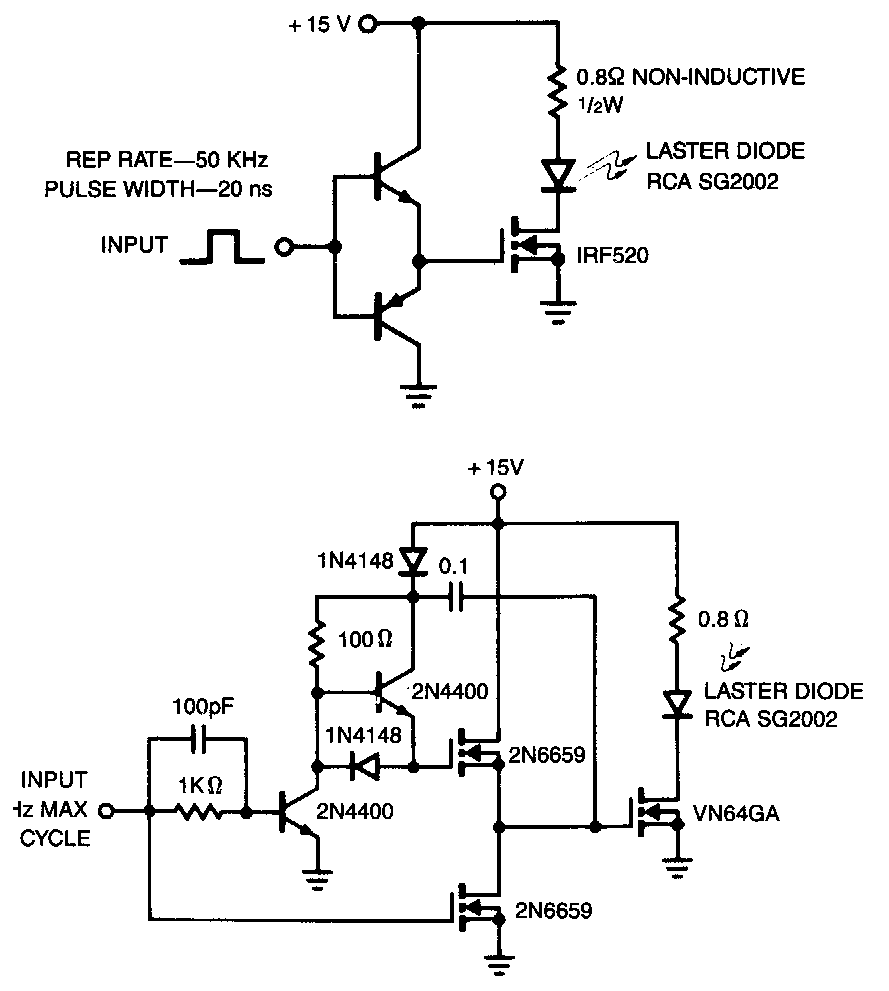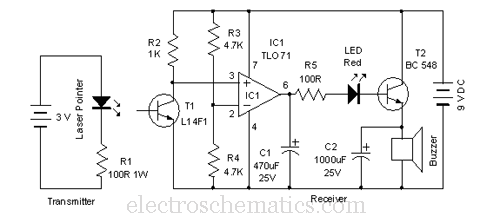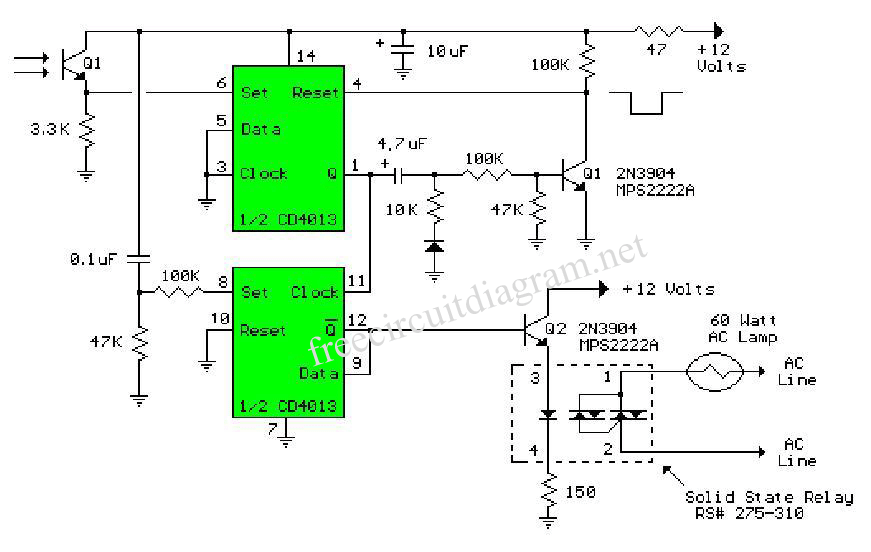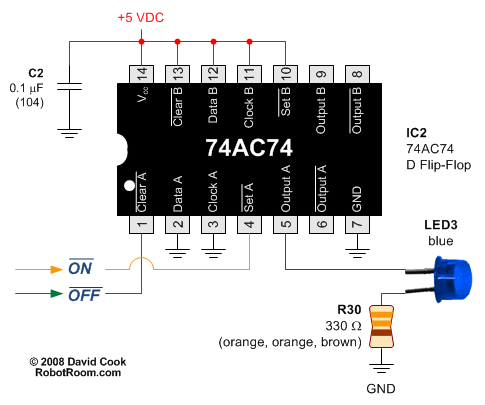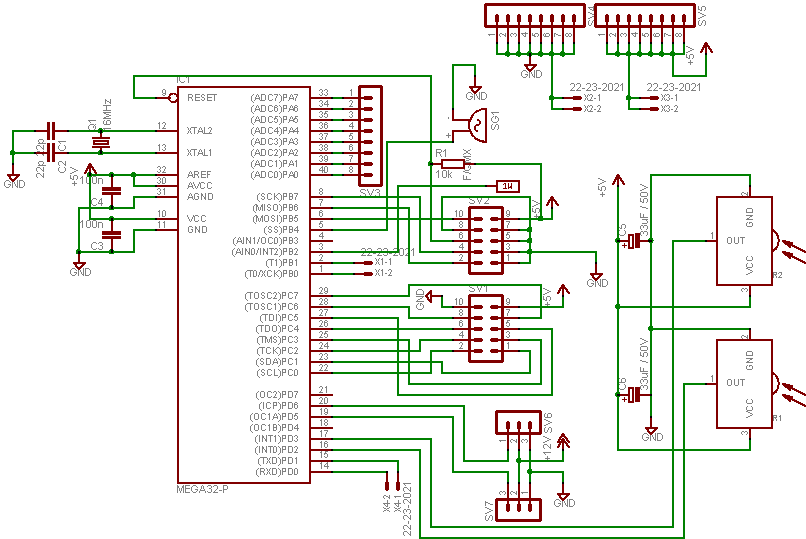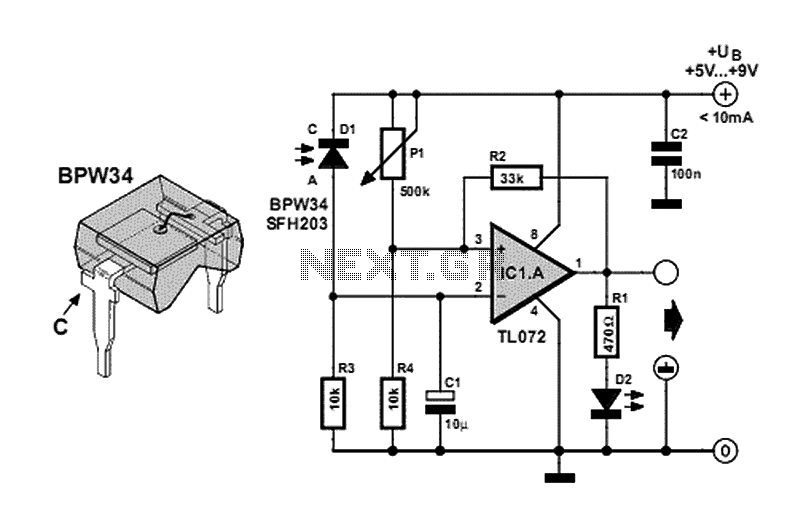
Home-Built Nitrogen (N2) Laser
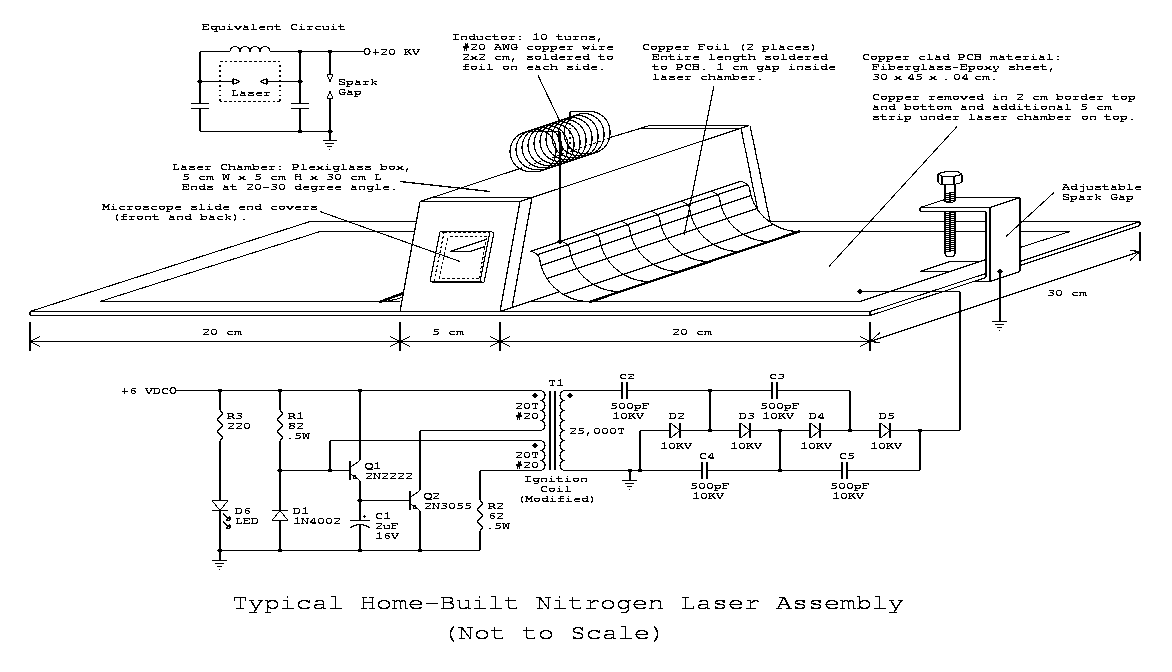
The nitrogen (N2) laser generates extremely short and intense pulses of light in the near ultraviolet (UV) spectrum, with a dominant wavelength of 337.1 nm. This laser is relatively easy to construct because it does not require mirrors; the gain medium (N2) is sufficiently high that a single pass through the discharge chamber produces a coherent UV pulse. A totally reflecting mirror can be added at the chamber's far end to enhance output by reflecting the portion of the beam that would otherwise escape. The lasing process is self-limiting, concluding within a few nanoseconds. The basic pulse power supply is simple and poses minimal danger compared to other home-built lasers. While a more powerful and hazardous supply is available for increased average power, it is not necessary. The nitrogen laser has a lower risk of failure if the design remains close to the original specifications. It does not require glass working, mirror alignment, or extensive vacuum systems, yet it produces results comparable to commercial units that are significantly more expensive. Although the UV output lacks the high beam quality of lasers like HeNe or CO2, it is still a legitimate laser. The high peak power is not suitable for materials processing due to the difficulty in focusing the beam to a small spot. However, it can effectively pump dye lasers and serve various applications requiring intense UV light, with appropriate safety measures against UV exposure. Despite its apparent simplicity, careful adherence to established designs is crucial for successful construction. The nitrogen laser has various applications beyond serving as a beginner's project, including optical pumping of dye lasers, UV spectroscopy, non-destructive testing, fluorescence measurements, and high-speed photography. The nitrogen laser was first discovered by H. G. Heard in 1963, with initial models producing only a few watts. However, optimizations have led to maximum outputs of at least 5 MW in practical discharge-pumped configurations, with pulse energies reaching about 20 mJ.
The nitrogen laser operates by utilizing molecular nitrogen (N2) as the gain medium. When an electrical discharge occurs in a low-pressure nitrogen environment, the nitrogen molecules are excited to higher energy states. As these molecules return to their ground state, they release energy in the form of UV photons, primarily at the wavelength of 337.1 nm. This emission is characterized by short, intense pulses, which can be effectively utilized in various applications.
The construction of a nitrogen laser typically involves a discharge chamber where the nitrogen gas is contained. The design can be simple, often utilizing standard materials that are readily available. The absence of mirrors simplifies the assembly process significantly, as the laser can generate a coherent output with just a single pass through the discharge chamber. The addition of a reflecting surface at the end of the chamber can enhance the output by recapturing some of the light that would be lost, although this is not essential for the laser to function.
The electrical power supply for the nitrogen laser is generally a capacitor discharge circuit, which provides the necessary energy to excite the nitrogen molecules. This circuit can be designed to be relatively safe, especially when compared to other high-power laser systems. While higher performance power supplies can be employed for increased output, they introduce additional risks and complexities.
Applications of the nitrogen laser extend beyond just being a hobbyist's project. Its ability to generate intense UV light makes it suitable for optical pumping of dye lasers, which are used in various spectroscopic techniques. It also finds use in non-destructive testing, where its short pulses can help identify material properties without causing damage. Furthermore, the nitrogen laser can be utilized in fluorescence measurements, allowing researchers to study the properties of different materials under UV light.
In summary, the nitrogen laser stands out for its simplicity in construction and versatility in application. While it may not match the performance of more advanced lasers in terms of beam quality, its ease of use and ability to produce intense UV light make it a valuable tool in both educational and research settings.The nitrogen (N2) laser produces intense extremely short (a few ns) intense (100 kW typical) pulses of light in the near UV portion of the E/M spectrum (337. 1 nm being the dominent line). Despite this impressive capability, the N2 laser is among the easiest to construct for the following reasons: Mirrors are NOT required.
The gain of the lasing me dium (N2) is so high that one pass through the discharge chamber is sufficient to produce an intense coherent UV pulse. A totally reflecting mirror of almost any type as long as it reflects UV can be added at the far end of the chamber to double the output if desired.
All it is doing is reflecting the half of the beam that would be otherwise lost out the other end of the box. In fact, a true resonator with a pair of mirrors would not help much at all. The lasing process is self limiting so all the exciting action is over in a few nanoseconds! The basic pulse power supply is very simple and not terribly dangerous (in a relative sort of way compared to most other home-built lasers).
A higher performance (and more dangerous) power supply is an option to boost average power but is not required. Compared to all the other home-built lasers, the nitrogen laser also likely has the lowest risk of failure IFF you stay pretty close to the SciAm design, more below.
No glass working, no mirrors, mirror mounts, or mirror alignment, minimal vacuum. Despite this, what you end up with isn`t substantially inferior to a commercial unit costing many kilobucks. It just lacks the convenience features and other bells and whistles. Now, the UV output isn`t in a tight high quality beam like that of an HeNe or CO2 laser but it is a real laser.
So, despite the high peak power, due to the lack of beam quality, the N2 laser isn`t going to be good for materials processing since it is very difficult to focus the N2 laser beam to a small spot. However, it can be used to pump a dye laser and for all sorts of other applications requiring intense UV (and safety precautions must be taken to guard against excessive UV exposure).
However, despite the apparent simplicity of the N2 laser, don`t be tempted to improvise before you get the SciAm design to lase. Even this simple laser can`t just be thrown together (despite what you might think from the humor in the section: Nitrogen Laser Construction on a Shoestring - this should not be taken seriously).
Start out with the same dimensions, materials, and construction techniques, and success is almost certain. While the SciAm N2 laser is not necessarily optimal or the highest power possible, it does work. Bigger is not necessarily better (or higher power but may actually be 0. 00 power. You can`t just increase the size of the capacitors and laser tube and expect it to do anything useful).
Once your N2 laser is operational, feel free to go hog wild experementing. But even then, change only one thing at a time! In case you are wondering, N2 lasers do have their uses besides being a good first laser for the home-built laser enthusiast. These include: optical pumping of dye lasers, UV spectroscopy, non-destructive testing, fluorescence measurements of materials, and measurements of very fast processes (nanosecond UV strobe for high speed photography).
Perhaps, these are not as glamorous as laser light shows and laser welding, but important applications nonetheless! The molecular nitrogen laser was discovered by H. G. Heard, who published an article about it in Nature in 1963. The first nitrogen lasers produced only a few watts, but people soon began to optimize them, and maximum power of at least 5 MW is possible in a realistic discharge-pumped device, with maximum pulse energies of about 20 mJ.
Higher powers have been reported in discharge-pumped nitrogen lasers, but have not been reproduced. Electron-beam pumping is also possible. Nitrogen emits primarily at 337. 1 nm, but is also reported to put out a small proport 🔗 External reference
The nitrogen laser operates by utilizing molecular nitrogen (N2) as the gain medium. When an electrical discharge occurs in a low-pressure nitrogen environment, the nitrogen molecules are excited to higher energy states. As these molecules return to their ground state, they release energy in the form of UV photons, primarily at the wavelength of 337.1 nm. This emission is characterized by short, intense pulses, which can be effectively utilized in various applications.
The construction of a nitrogen laser typically involves a discharge chamber where the nitrogen gas is contained. The design can be simple, often utilizing standard materials that are readily available. The absence of mirrors simplifies the assembly process significantly, as the laser can generate a coherent output with just a single pass through the discharge chamber. The addition of a reflecting surface at the end of the chamber can enhance the output by recapturing some of the light that would be lost, although this is not essential for the laser to function.
The electrical power supply for the nitrogen laser is generally a capacitor discharge circuit, which provides the necessary energy to excite the nitrogen molecules. This circuit can be designed to be relatively safe, especially when compared to other high-power laser systems. While higher performance power supplies can be employed for increased output, they introduce additional risks and complexities.
Applications of the nitrogen laser extend beyond just being a hobbyist's project. Its ability to generate intense UV light makes it suitable for optical pumping of dye lasers, which are used in various spectroscopic techniques. It also finds use in non-destructive testing, where its short pulses can help identify material properties without causing damage. Furthermore, the nitrogen laser can be utilized in fluorescence measurements, allowing researchers to study the properties of different materials under UV light.
In summary, the nitrogen laser stands out for its simplicity in construction and versatility in application. While it may not match the performance of more advanced lasers in terms of beam quality, its ease of use and ability to produce intense UV light make it a valuable tool in both educational and research settings.The nitrogen (N2) laser produces intense extremely short (a few ns) intense (100 kW typical) pulses of light in the near UV portion of the E/M spectrum (337. 1 nm being the dominent line). Despite this impressive capability, the N2 laser is among the easiest to construct for the following reasons: Mirrors are NOT required.
The gain of the lasing me dium (N2) is so high that one pass through the discharge chamber is sufficient to produce an intense coherent UV pulse. A totally reflecting mirror of almost any type as long as it reflects UV can be added at the far end of the chamber to double the output if desired.
All it is doing is reflecting the half of the beam that would be otherwise lost out the other end of the box. In fact, a true resonator with a pair of mirrors would not help much at all. The lasing process is self limiting so all the exciting action is over in a few nanoseconds! The basic pulse power supply is very simple and not terribly dangerous (in a relative sort of way compared to most other home-built lasers).
A higher performance (and more dangerous) power supply is an option to boost average power but is not required. Compared to all the other home-built lasers, the nitrogen laser also likely has the lowest risk of failure IFF you stay pretty close to the SciAm design, more below.
No glass working, no mirrors, mirror mounts, or mirror alignment, minimal vacuum. Despite this, what you end up with isn`t substantially inferior to a commercial unit costing many kilobucks. It just lacks the convenience features and other bells and whistles. Now, the UV output isn`t in a tight high quality beam like that of an HeNe or CO2 laser but it is a real laser.
So, despite the high peak power, due to the lack of beam quality, the N2 laser isn`t going to be good for materials processing since it is very difficult to focus the N2 laser beam to a small spot. However, it can be used to pump a dye laser and for all sorts of other applications requiring intense UV (and safety precautions must be taken to guard against excessive UV exposure).
However, despite the apparent simplicity of the N2 laser, don`t be tempted to improvise before you get the SciAm design to lase. Even this simple laser can`t just be thrown together (despite what you might think from the humor in the section: Nitrogen Laser Construction on a Shoestring - this should not be taken seriously).
Start out with the same dimensions, materials, and construction techniques, and success is almost certain. While the SciAm N2 laser is not necessarily optimal or the highest power possible, it does work. Bigger is not necessarily better (or higher power but may actually be 0. 00 power. You can`t just increase the size of the capacitors and laser tube and expect it to do anything useful).
Once your N2 laser is operational, feel free to go hog wild experementing. But even then, change only one thing at a time! In case you are wondering, N2 lasers do have their uses besides being a good first laser for the home-built laser enthusiast. These include: optical pumping of dye lasers, UV spectroscopy, non-destructive testing, fluorescence measurements of materials, and measurements of very fast processes (nanosecond UV strobe for high speed photography).
Perhaps, these are not as glamorous as laser light shows and laser welding, but important applications nonetheless! The molecular nitrogen laser was discovered by H. G. Heard, who published an article about it in Nature in 1963. The first nitrogen lasers produced only a few watts, but people soon began to optimize them, and maximum power of at least 5 MW is possible in a realistic discharge-pumped device, with maximum pulse energies of about 20 mJ.
Higher powers have been reported in discharge-pumped nitrogen lasers, but have not been reproduced. Electron-beam pumping is also possible. Nitrogen emits primarily at 337. 1 nm, but is also reported to put out a small proport 🔗 External reference
